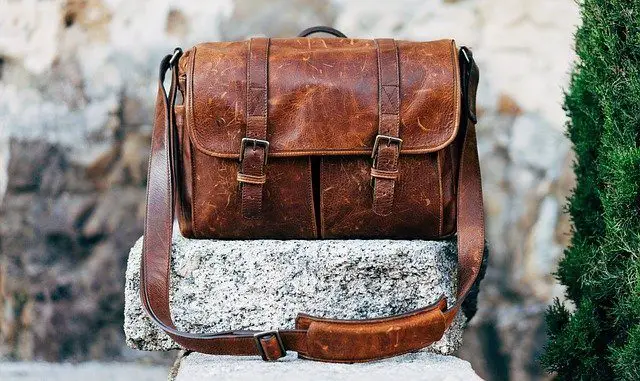Messenger Bag Vs Backpack (Which Is Better?)
When you’re deciding on a new bag, the choices aren’t thin on the ground. If you’re looking to upgrade your style or have better security in your bag, the many options and buzzwords can become confusing.
Worry not! This guide will help you understand the difference between a messenger bag vs backpack and help you choose which is right for you.
What is a Messenger Bag? (Common Uses + Pros & Cons)
A messenger bag comes with a cross-body strap and, sometimes, a handle. As of recent, it has become the replacement for briefcases. The name comes from a type of satchel that mail carriers or couriers used.
Today they’re used for carrying laptops and paperwork, and usually have multiple storage compartments.
Pros
Cons

What Exactly is a Backpack? (Common Uses + Pros & Cons)
Backpacks are incredibly versatile. They are designed with two straps that sit on your shoulder, distributing the weight evenly. They are deeper with more carrying room, meaning they’re better for packing more into your bag.
Nowadays, backpacks are designed for more protection of your electronics and essentials for better travel.
Pros
Cons
Messenger Bag vs Backpack: Which is Right for You?
for College/School
Generally, it all depends on your situation. If you are carrying a laptop, iPad, or tablet around, along with textbooks, notebooks, and other accessories, then a backpack might be a better option. Backpacks have two straps, which distribute the weight evenly. A messenger bag can strain your shoulder after a long day of carrying heavy books and computers.
If it’s a hot day, backpacks can lead to a sweaty back, which can be uncomfortable. A messenger bag sits to the side, eliminating a bulky weight on your shoulders. You may also feel more secure with a messenger, as the bag can be manoeuvred to the front quickly.
for Travel
It is widely accepted that a backpack is better when you’re traveling. If you are on your feet all day with a lot of stuff to carry, a backpack will distribute the weight evenly on your back. A backpack will also have more room than a messenger to carry all your essentials; a water bottle, phone charger, lunch and/or dinner, etc., will fit in nicely. A messenger bag, while wider, might not have the same amount of room to carry everything.
If it’s a short trip or a carry-on, then a messenger bag can work well. The smaller design will be less clunky on an airplane and will fit nicely in the overhead storage.
for Work
As messenger bags have slowly become the replacement for briefcases over the years, it appears more professional to use. Messenger bags have more sleek and simple designs to them that work well in office settings and are good at carrying smaller items, such as laptops and paperwork.
Backpacks, on the other hand, may make you look more approachable. They appear more casual, and they also come with professional and simple designs. Backpacks work for longer journeys to work, especially if you’re a commuter. There is more room in a backpack to carry your workload, with less strain on your shoulders. If you take the train to work, consider a neatly designed backpack.
for Back Pain
For people who suffer from back pain, messenger bags are a no-go - we would recommend a backpack designed for people with back pain. They have one strap that hangs from one side, which puts all the weight onto one side of your body.
Carrying the weight on one side leads to neck stiffness, backaches, and sore shoulder muscles. Backpacks have two straps that distribute the weight on both of your shoulders, giving you a more comfortable experience. Backpacks will make you slouch less as the weight will straighten your posture.
If you want a messenger bag and suffer from back pain, try opting for a wider, padded strap or switch shoulders once it becomes uncomfortable.

People Also Ask (FAQs)
What size messenger bag should I get?
It depends on its use. If you are carrying a lot to school and work, opt for a wider messenger. For casual use, you can find comfort in a smaller bag. Read our size guide here.
How do you wear a small messenger bag?
How do you wear a backpack properly? If you’re wearing it to the side, the strap should be made longer. For over the torso, make the strap shorter. Generally, it should sit at your lower back or below.
What is the difference between a satchel and a messenger bag?
Satchels were designed for scholarly use – carrying books and papers, and came with two straps to become a backpack. Messenger bags have their roots in the pony express for mail delivery.
Conclusion
Deciding on a new bag is a monumental choice – this is what you will use day-in-day-out to carry your essentials with you. Making sure it’s the right style and comfort for you is no easy task, so hopefully, this guide made the decision easier. One strap or two? The choice is yours!
